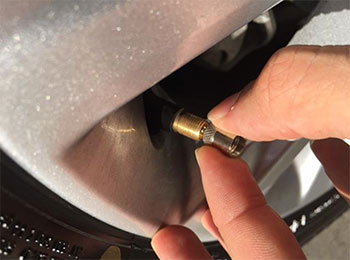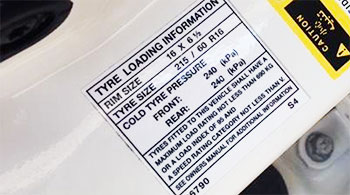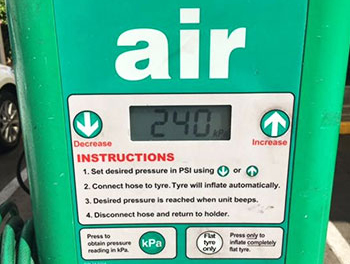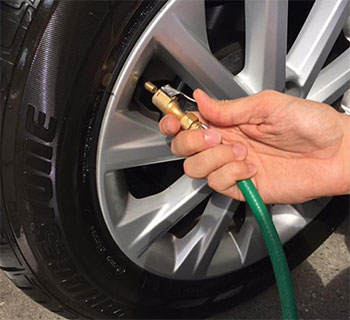-
General Tyres
-
OTR Tyres
-
Batteries
Need a new battery?Our stores stock a wide range of batteries for all vehicle types. - Stores
-
Corporate
Commitment to qualityBridgestone Tyres Papua New Guinea is the tyre industry market leader, renowned for producing quality products and being at the forefront of technology, innovation and continuous improvement.
Tyres for all
vehicle types
How to check car tyre pressure
- General Tyres
- / How to check car tyre pressure
How to check car tyre pressure
Save fuel, increase on-road safety, and get more life out of your tyres by making sure they are properly inflated. Bridgestone explains how to check your tyre pressure and pump up your tyres to perfection.
Why it's important to check your tyre pressure
When was the last time you checked the pressure of your tyres? If you haven’t checked your tyres in over a month, then you might just be wasting fuel, and risking your safety.
Correct tyre pressure is important for three main reasons. Firstly, badly inflated tyres make it harder to handle your car on the road, impairing your ability to steer, corner, accelerate and brake. Secondly, over and underinflation wears your tyres down quicker, as the wrong parts of the rubber make contact with the road. Lastly, incorrect tyre pressure increases rolling resistance, burning more fuel and sending your fuel economy out the window.
So what are you waiting for? Learn how to check your tyre pressure and refill your tyres below.

To refill your tyres to the correct pressure, you’ll need an air compressor. You can buy a portable air compressor from an auto parts store, but we recommend you simply pop into a petrol station - air compressors there are usually free, and most can automatically fill your tyre to a chosen pressure.
For the best results, you’ll also need a tyre pressure gauge. You can use a manual gauge, or upgrade to digital for an easier experience.
We also recommend you check for pressure and inflate your tyres when they are cold. Your tyres will be cold if your car has been parked for at least three hours, or has been driven less than 2km at a moderate speed. So it’s best to find a petrol station that’s close by.
Step 1: Check the recommended tyre pressure
Before you can start checking your tyres, you’ll need to know what pressure is ideal. To do this, you’ll need to find the tyre pressure recommended by the manufacturer of your car. You can usually find this information on the driver’s side door frame, inside the fuel door, in the glove box, or in your car’s manual.
If you can’t find the recommended pressure, you should consult your vehicle dealer, manufacturer, or a qualified tyre professional.

Step 2: Check your tyre pressure
Many petrol stations now have automatic tyre inflation. Simply set the desired pressure in kPa or PSI, then attach the lead to the valve of each of your rims. Attach the lead firmly to the valve, the machine will do the rest. If an automatic machine is not available, pressure will need to be added or removed then checked with a tyre pressure gauge.

Step 3: Fill your tyres
Now, it’s time to refill your tyres to the perfect pressure. The process is slightly different depending on which type of air compressor you are using. Check which steps are right for you below, and make sure to always follow the instructions on your air compressor.
- If your air compressor allows you to set the desired tyre pressure, enter the correct kPA. Generally, this should be the recommended manufacturer pressure you found in step one. However, if you’ve recently driven your car more than 2km, and your tyres are hot, we’d recommend increasing the pressure by 20-50 kPA.
- Remove the valve cap from your tyre.
- Attach the air compressor hose to the valve stem. You can see in the picture below where you’ll need to attach the hose. Make sure you push on the hose so that air can’t escape while the tyre is filling.
- Press on the lever to fill your tyre. If you’re using an automatic tyre compressor, simply hold down the lever until you hear a beep. When the beep sounds, your tyres are at the set pressure. If you’re using a manual air compressor, you will need to press the lever and let air into your tyre in short bursts, checking tyre pressure regularly and repeating as needed.
- Be aware that petrol station compressors can be inaccurate and may require you to double check the pressure with your own gauge to make sure the pressure is perfect.
If you find your tyre is overinflated, release some air by turning the valve cap around and then pushing on the valve core, or with your fingernail. If you find your tyre is underinflated, reattach the hose and refill your tyres, slightly increasing the desired kPA. Then, check the pressure is correct once you have finished.


Along with the manufacturer's name and the name of the tyre (e.g. Bridgestone Ecopia), there's always a set of numbers and letters that relate to the size of the tyre.
Here's a rundown on what those numbers mean:
205 is the section width of the tyre in millimetres.
60 is the aspect ratio or tyre profile.
R means it is radial construction.
15 is the diameter of the wheel rim in inches.
We use cookies to ensure you get the best experience. View privacy policy.


